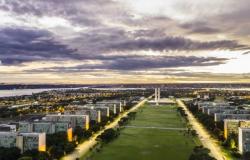Just an hour’s drive from Rome, local skiers have made the Apennine Mountains their winter playground for decades. But this season, the normally pristine white resort looks more like a muddy wasteland. The few working chairlifts glide over bald hills, with hikers riding where snowboarders are normally seen.
With an exceptionally warm winter, resorts like Campo Felice have a big problem: there is no snow. And a prolonged drought means there isn’t enough water to produce the amount of artificial snow needed to paint its slopes white.
What little snow the resort owners produce is in constant threat of melting in the heat. But they managed to create enough for four lanes – slender patches of white on the bald brown hills. It’s something, but a far cry from your usual 14 tracks.
After the hottest year ever, this year’s February was the hottest ever recorded in the world. Climate change and El Niño contributed to this, which resulted in a miserable ski season in many places in the northern hemisphere.
The devastating loss of snow has particularly affected skiing in Europe, including the Alps and Dolomites north of Campo Felice.
The climate crisis is making winters milder and shorter in many parts of the world, but Andrea Lallini, who runs Campo Felice with her brother, says this year it was as if winter never showed up. It was the worst in the 23 years his family has run the resort. All the snow that exists is artificial.
“The problem this year is that there has been no precipitation and, furthermore, it has never been cold,” he told CNN.
“We were supposed to open in December, but we couldn’t even make snow until mid-January,” he said, explaining that at that time it was too hot to make snow.
Temperatures have to be below freezing for artificial snow to set, and this year there haven’t been enough days for that. And with a lack of rain and record heat waves, the lakes that normally provide water for artificial snow have dried up. This season, the resort is literally buying water to power its snowmaking machines.
Lallini fears that if there are more difficult times, the entire operation could become unsustainable.
Skis on the muddy soil of Campo Felice. Fiona Sibbett/CNN
One of four slopes made of artificial snow. Fiona Sibbett/CNN
But Campo Felice is by no means the only one feeling the heat.
According to Carlo Carmagnola, an expert at Météo France who studies the impact of climate change on ski resorts, around 90% of Italian ski resorts use artificial snow. In the French Alps, the percentage is 40%. In Austria, it reaches 80%.
“These systems are not perfect, in the sense that you need to have temperatures and humidity conditions that are low enough to be able to produce snow,” Carmagnola told CNN. “And then, of course, you need water. And currently, one of the most sensitive issues is the availability and access to water resources, which in some valleys is already complicated, with conflicts at specific times of the season between agriculture, drinking water and snow production.”
Snowmaking is incredibly energy-intensive, and if the cannons used to make it run on fossil fuels, the process contributes to global warming – which is why natural snowfall is dwindling.
There is also fear that the accumulated snow could reach a tipping point that will cause it to decline more quickly. A recent study demonstrated that when average winter temperatures rise above -8 degrees Celsius in a given location, accumulated snowfall decreases rapidly. Even small increases in temperature above this point accelerate snow loss.
Without snow there are no jobs
Andrea and her brother, Luca Lallini, are running the family business under conditions that are radically different from those their father faced when he opened the resort.
In the 1980s and 1990s, Campo Felice didn’t need artificial snow, Luca Lallini told CNN, as he flipped through old photographs of snow so deep it had to be removed from the windows of the resort’s restaurants and bars. Now, those same facilities are closed, surrounded by land.
These changes have been difficult not only for the Lallini brothers, but also for their employees, who normally number 250 during the ski season. This year, only 50 have been called to work so far.
“On a normal Sunday in February, we would see more than 6,000 people on all the tracks,” Lallini told CNN. “This year, we don’t even have 500 people for an entire weekend.”
The end of year holidays and the month of February are normally the best times in the region. Holidays in Italy include the annual “settimana bianca,” or white week, in February, when schools close across the country so families can go skiing. Currently, the Italian media jokes that the holidays have been another green settimana, with almost half of the country’s ski slopes only partially open or even closed.
The ski industry in this part of Italy is the region’s main employer, said Gennarino Di Stefano, the mayor of Rocca di Cambio, the highest-altitude town in these mountains.
“The effects of the lack of snow cause a series of problems,” he says, looking out over the muddy fields. According to him, all the cities in the region are deeply committed to skiing, which provides employment for ski instructors, managers, bar and restaurant staff and people who operate the ski lifts, coming from all over the region.
“A lot of people are not working,” he said.
An old photograph showing a typical snowy season. In the 1980s and 1990s, Campo Felice did not need artificial snow. Fiona Sibbett/CNN
The lack of snow also affects future skiers – the central Italian Apennine region is very popular with young winter sports athletes.
Isidoro Francesi, ski instructor in Campo Felice, says that young competitive skiers had to look for other places at higher altitudes, where snow is more abundant, to train. Typically, this also means traveling further north.
“This is expensive for families, but it is also an increased economic loss. We are all working less,” he said. “For those of us who have always worked here, it is heartbreaking to see nature ruined in this way.”
CNN’s Camille Knight contributed from Paris, and Antonia Mortensen contributed from Rome.






